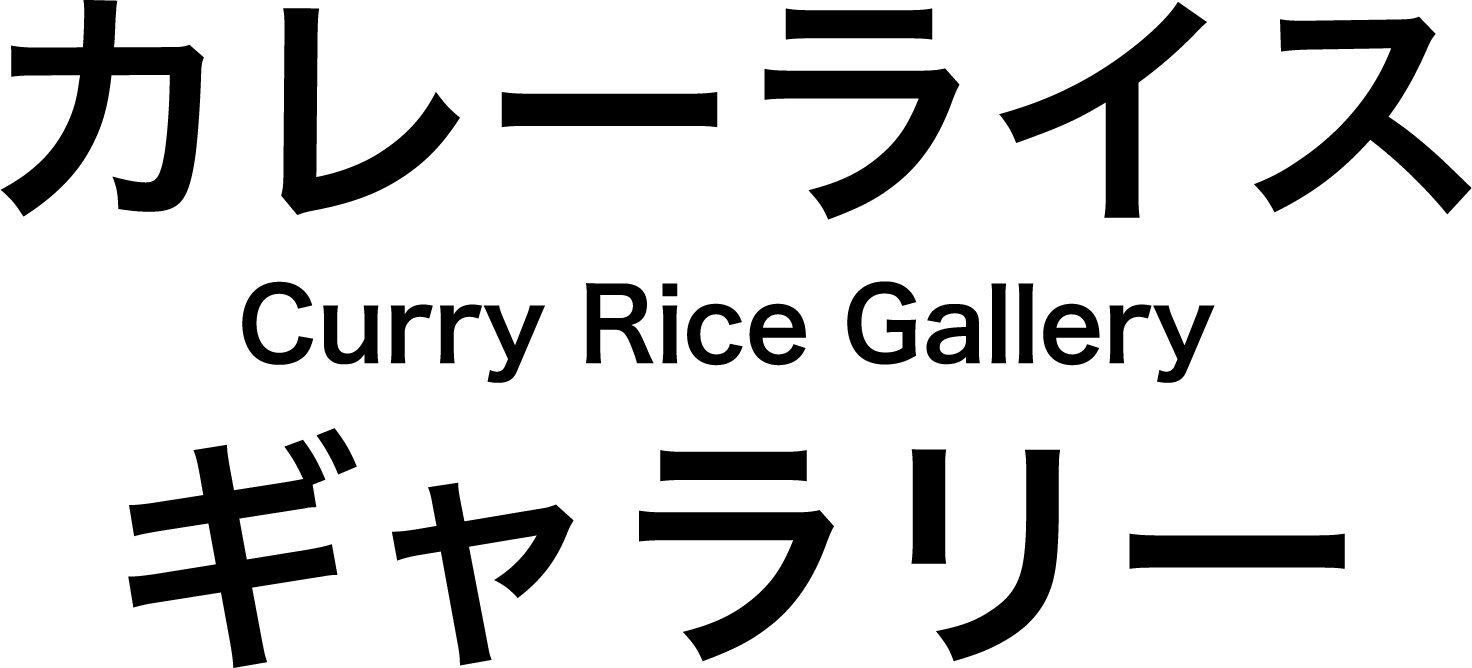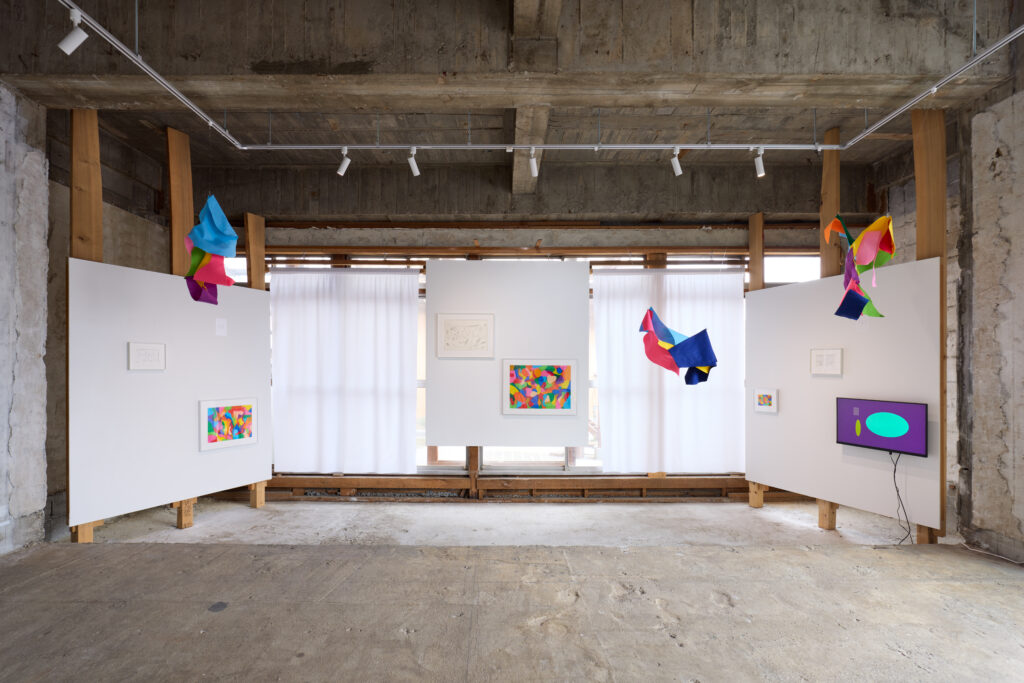
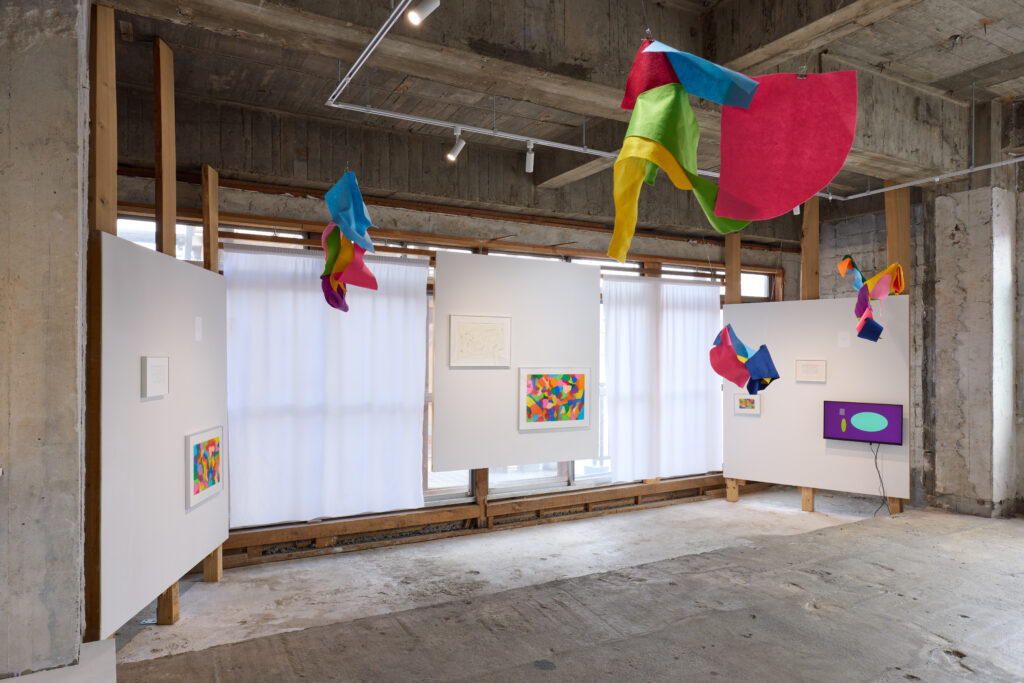
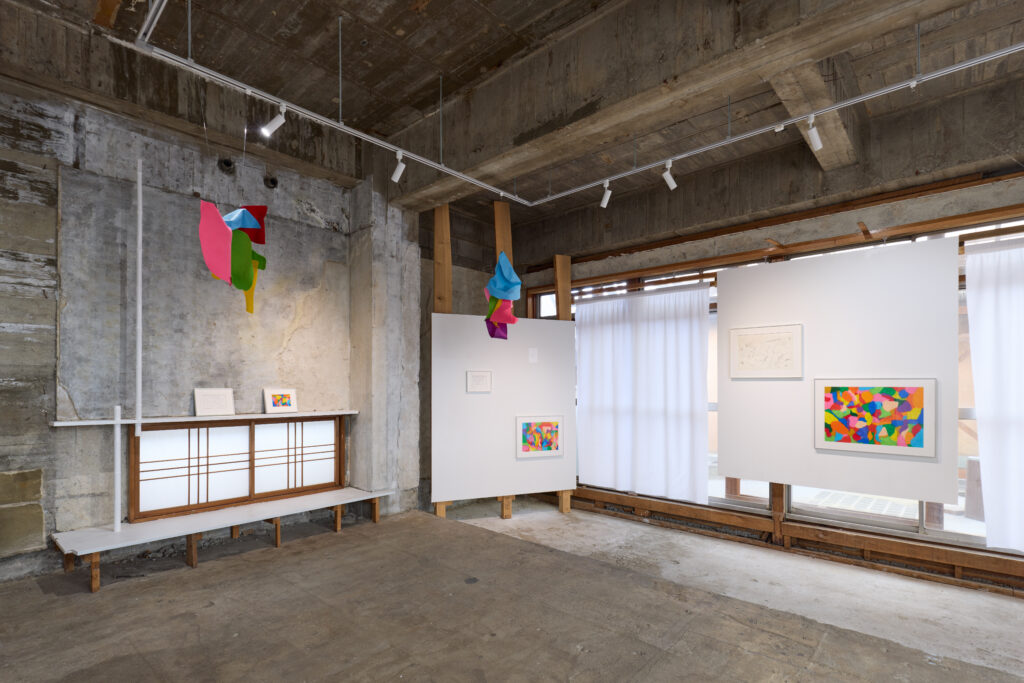
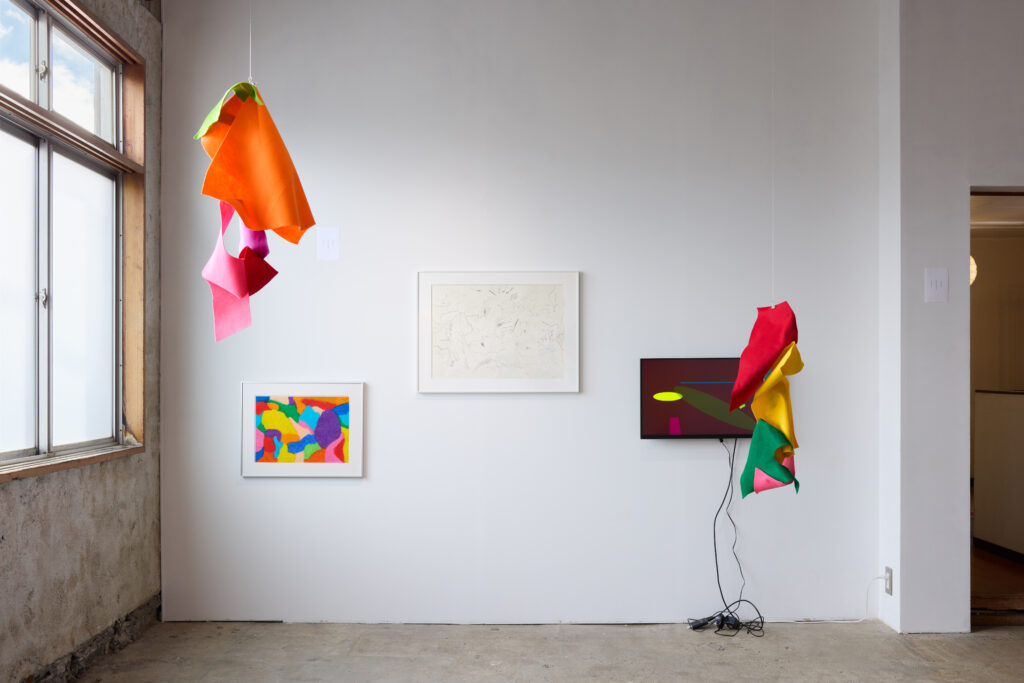
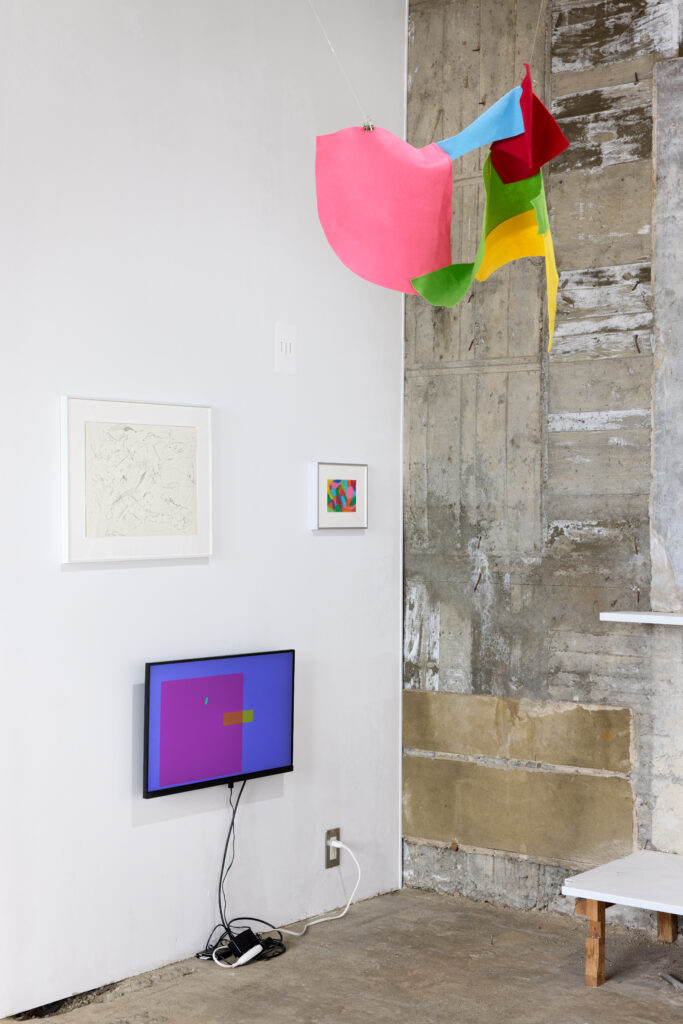

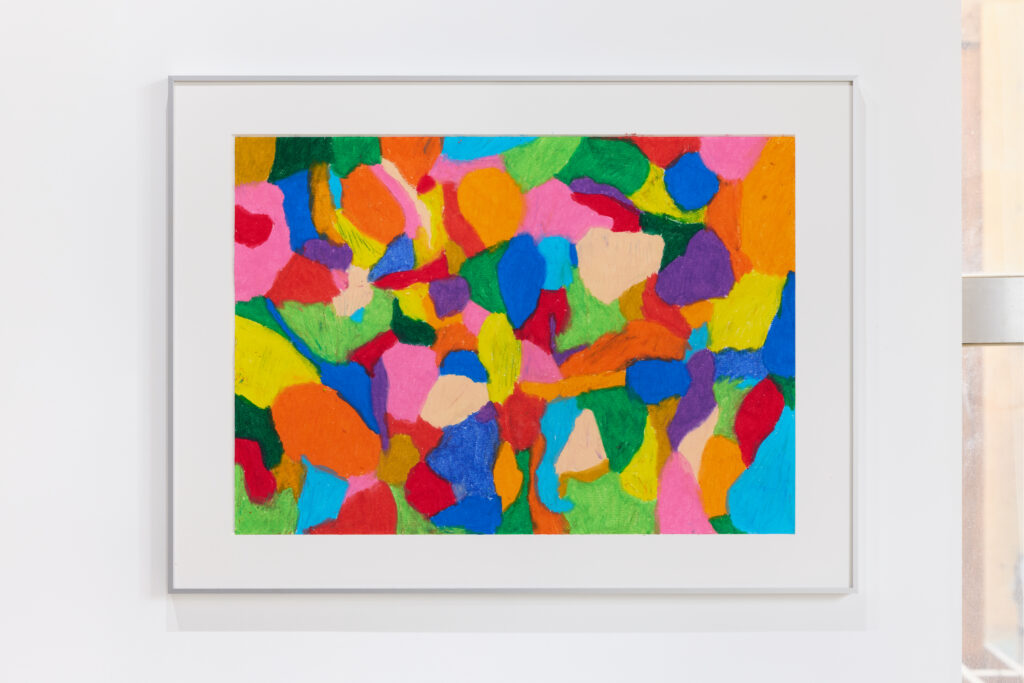
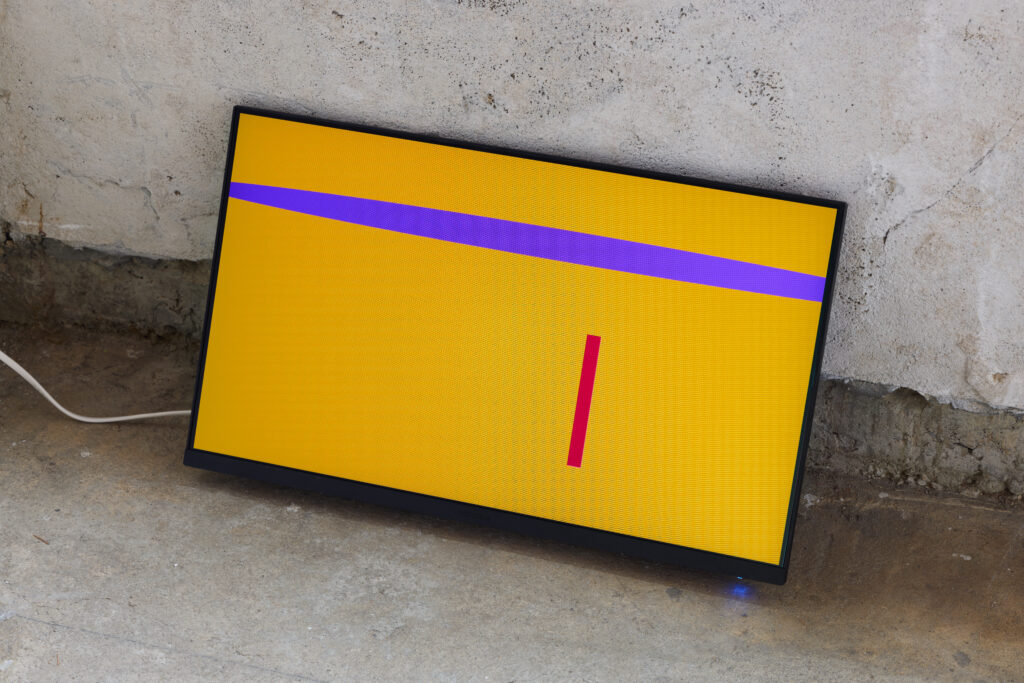

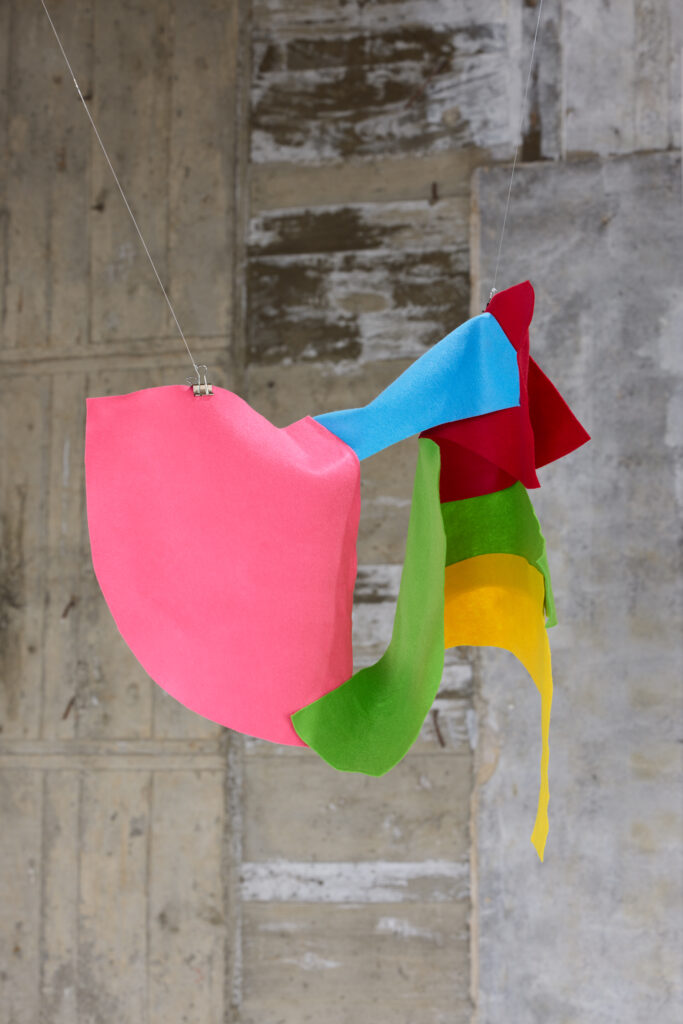
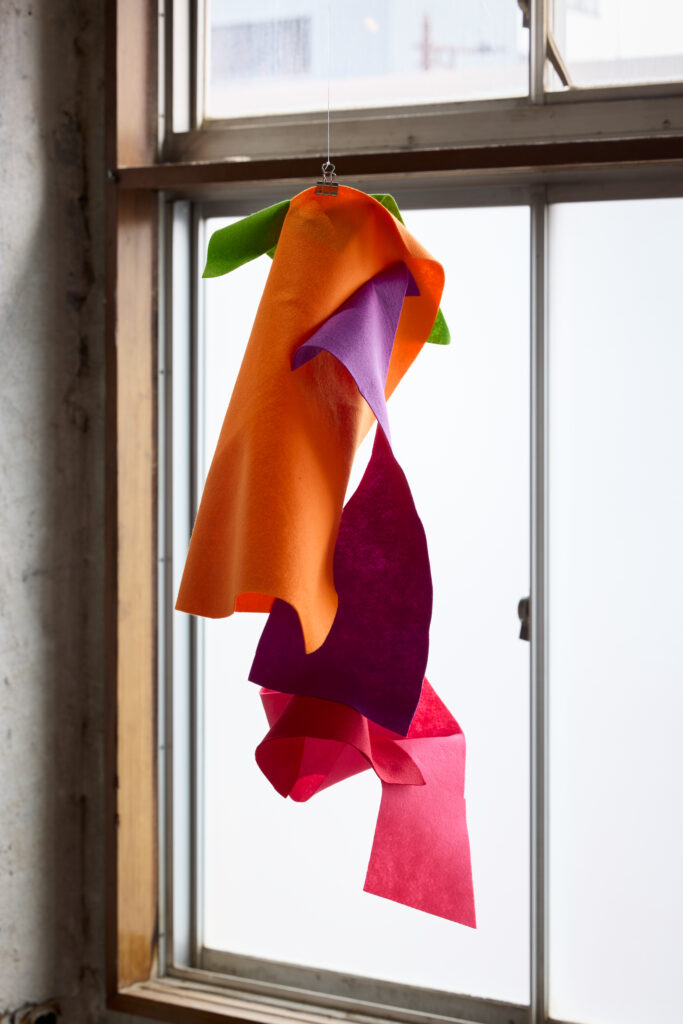
photo: 稲口俊太
ー
ひらがなの特に意味をもたないような不思議な羅列のこの展覧会タイトルは、アーティストさとうこけこ考案のタイトルです。
俳句の形式を踏襲しながらも、まったくといっていいほど、その内容を意味なく使い、けれどもその響きから詩的な感覚を感じさせます。
これは、まずどのような展示があるかということを知るという、ある種の予兆にふさわしい響きとといってもよいでしょう。
今回の展示は、Y・Nのドローイングに象徴されるように、非言語的なコミュニケーションを基盤としながら、プイマ=セカのカラフルなマチエールに取り込まれるように、あるいは大塚恵美の時間感覚に飲み込まれるように、もしくは、マリアナ・コスタのフェルトのアッサンブラージュに畳み込まれるように、観客を意味以前の造形が織りなす世界へと連れて行きます。
楡木真紀(本展キュレーター)
ー
「あゆさゆみ しなそのなこす すさのよせ」
日時:2025年7月12日〜7月21日
会場:O CHA NO MA 〒962-0845 福島県須賀川市中町17−8
展示作家:さとうこけこ、Y・N、プイマ=セカ、大塚恵美、マリアナ・コスタ
キュレーション:楡木真紀
ー
さとうこけこ
テキストアーティスト。俳句の形式である5・7・5の文字列でありながら、特にこれといった意味をなさないようなひらがなを選び、抽象的な作品としている。主なパフォーマンスに、2024年「マジック・マジック・サンシャイン?どんなスニーカーも空を飛ぶ」O CHA NO MA(福島)、「一那由多のちょんまげスプーン」千秋公園大手門の堀遊歩道(秋田)など。今回の展示タイトルも考案した。
Y・N
アーティスト。非言語的な造形感覚として、線やパターンが変化する有様を描写したようなドローイングを制作している。また、ドローイングは通常の販売というかたちの他にも販売した金額を震災や戦争の被災者へ寄付するチャリティや、交換や寄贈というかたちなど様々な方法によって流通させている。また、別名義に、Y・N_2、Y/N、*Y・Nなどがいる。主な展示に、2022年「第2回藁工アンパンArt BAZAR」藁工ミュージアム(高知)、2023年「Fluffy Society」KOGANEI ART SPOT シャトー2F(東京)、「仙台アンデパンダン展」Gallery TURNAROUND(宮城)、2024年「Drawings 2024」Stela(福岡)、「becoming」TINGOO GALLERY(南京、中国)、「Drawings 2024」callbox(東京)、「石巻のキワマリ荘 常設展2024」GALVANIZE gallery(宮城)、「ちっちゃい美術展」芸宿(石川)、「仙台アンデパンダン展」ギャラリーチフリグリ(宮城)、「CHICHAI」Brasserie Pain Liquide(パリ、フランス)、「救済?」GALVANISE gallery(宮城)、「イノビエンナーレ2024」いの町紙の博物館(高知)、2025年「脱臼する資本主義 Dislocated Capitalism」Syndicate(香川)など。主なパフォーマンスに、2024年「うあーパフォーマンスフェスティバル vol.5」白河市街地(福島)「トノサマバッタのハッピーバースデーパーティーについて行った!」Maebashi Works(群馬)など。
プイマ=セカ
アーティスト。クレパスによって、オールオーヴァーで色彩豊かな色面の平面作品のシリーズなどを制作している。今回が物理的な発表では初展示となる。
大塚恵美
アーティスト。色彩詩学と独自に名付けた詩学をベースに、色彩によって構成する画面を詩として表現している。表現手法は、グラフィックからアニメーション、インスタレーションまで多岐にわたる。
マリアナ・コスタ
アーティスト。彫刻家。さまざまな色のフェルトを用いてアッサンブラージュ的なインスタレーションのシリーズなどを制作している。日本での発表は今回が初めて。
楡木真紀(キュレーション)
詩人。アーティスト。主に無目的な意味の関係性を目指した散文詩の執筆や全くもって関係のないナンセンスなことを書く自由日記、レディメイドのインスタレーションを制作したり、柔らかい鏡を使ったパフォーマンス、他のアーティストのパフォーマンスや個展タイトルの考案などをしている。主な展示に、2024年「王国がくしゃみをするとき、あなたはマイクロウェーブしている?」callbox(東京)、「成功への第一歩は、ハッピーハッピーガムテープ、ミケランジェロ風アイスクリームにな〜れ!から始まります」Curry Rice Gallery(オンライン)、2025年「脱臼する資本主義 Dislocated Capitalism」Syndicate(香川)、「人類史は99%水分でできている」Mineral Water Gallery(Meta Metaverse)など。主なパフォーマンスに、2024年「一那由多のちょんまげスプーン」千秋公園大手門の堀遊歩道(秋田)、「しまうまのお腹でそのUFOは休憩をする」門司港駅周辺(福岡)など。
ー
レビュー『カラフルな森の、木のうろで、予言の鳥が鳴いている ――「あゆさゆみ しなそのなこす すさのよせ」に寄せて』平岡希望
茄子の背泳ぎを鑑賞する会に参加したのは、君だけだよ。キリンにあいさつをして、名探偵には餃子を焼いておいて。水晶玉を流しそうめんで流せば万事解決。長靴の中でリモコンがたくさん沸いてるね。
(楡木真紀『自由日記 2024/07/16』https://creamsodamuseum.org/%e6%a5%a1%e6%9c%a8%e7%9c%9f%e7%b4%80/ )
…と紡がれていく言葉みたいな “突拍子もなさ” で、リノベーションされた雑居ビル2階、古風なアパートめいた飴色の内階段脇の、そこだけ一段高くなった細いフローリングの2、3歩先の引き戸の向こうに現れたのはコンクリート打ちっぱなしの空間で、床に足を下ろしながらも、目は左上のほうに惹きつけられていたのはカラフルなミノムシじみたモビールが浮いていたからだ。赤・黄色・ピンク・水色・きみどりのフェルトが1枚ずつ繋げられたそれは「マリアナ・コスタ」の作品で、それぞれのフェルトはランダムに切り出されているようだが、袖や身頃の形にも見えるのはやわらかな質感のためだろう。高い天井のレールから、ダブルクリップ2か所で吊られたそれの周りを、“6時” から “9時” の方向へと移動する間にも、赤→水色→ピンク→きみどり→赤と、メビウスの輪のごとくねじれ、たわんだ環状になっていることがうかがえて、きみどりにくっついた、“Qの尻尾” みたいな黄色のフェルト越しに部屋の反対側が見える。
並んだ2組の引き違い窓はそれぞれ右側が細く開けられていて、目の前の “Q” が、そして点在するほか5つの “ミノムシ” が不規則にゆらめいているのは風の仕業らしい。13時過ぎの日差しもまた、2つの小さな平行四辺形となって床で遊んでおり、これからゆっくりと動き、形を変えていくだろうそれらを早回ししたように、窓辺に目をやる私の真右、出入り口沿いの壁に掛かったモニターでは、爪の先ほどの付箋みたいな水色の四角形が、高速で円を描いていた。「大塚恵美」の作品だ。
重ね置いた折り紙を真上から見るように、藤色の背景の向かって左には二回りほど小さなショッキングピンクの長方形があるのだけれど、それはゆっくりと中央へ移動していて、水色は小舟のように、そのピンクの上を時計回りに泳いでいる。藤色の中央で、ピンクの右辺に半ばかかっている黄色の帯だけは半透明だから、動くピンクのせいでリトマス試験紙みたいに染まっていくのだが、お風呂で膨らむおもちゃみたいに黄色はだんだん大きくなって、水色が高速回転するのは、ピンクが中央から左へ引き返している途中のことだ。その回転をきっかけとしたかのように黄色はしぼんでいって、最後には、すでに回転運動を止めた水色よりも小さくなったけれど、一連の動きがコンテンポラリーダンスのようにも見えたのは、
ピンク:画面左から右へゆっくり動いて戻る。
水色:ピンクの上でゆっくり1周してから高速回転する。
黄色:画面中央で大きくなってから小さくなる。
個々の小さなルールが、自律的に駆動されていたためではないか。
中村悠一郎さんの名義たちが収蔵されている Cream Soda Museum(https://creamsodamuseum.org/ )を開けば、ほかにも、「自分自身の声を複数録音し重ね合わせることによって、多声性を持ったポリフォニーの即興音楽を制作」する「小岩慶介」をはじめ、「林家豪」「オルゼミス・ネフィカルト」「サクセスフルティーポット」など、異なる素材や形式を用いつつも「重ね合わせ」を手法とする作家が複数掲載されており、「大塚恵美」もまた、その系譜に連なる作家といえるかもしれない。というより、もちろん程度の差こそあれ、重ね合わせる、言いかえればある統一的なイメージに塗りこめるのではなく、作品の各要素を混ぜきらず、鑑賞者が視線によって “ほどく” ことができる状態に留めることと捉えれば、より多くの名義に共通しているだろう。それは、「楡木真紀」によってキュレーションされた本展もまたそうで、コンセプトというより、色彩や造形性によって組み合わされた作家5名のうち誰かと、たとえば対象を接写することで、色彩のコンポジションにすら見えるほど具象性を解体する写真家「てりやき」とを入れ替えても成立したかもしれない。そして、目の前のフェルトや映像中の図像もまた、別の組み合わせだった可能性に開かれていて、そうした即興性や仮設性は、
多孔性または有孔性とは、異種のガス体どうしが混同して相互拡散しつつも化学的に結合することなく、自立的に存在するという現象を説明するために、近代原子論の提唱者、ドルトン(John Dalton 1766-1844)が提起した仮説に由来するものである。この仮説は、それぞれの物質が自立的でありながら、それ自身のうちに無数の微小で空虚な間隙、すなわち孔(穴)をもち、この孔を出入りすることによって相互に循環・滲透しあうと考えるものである。ヘーゲルは、一方ではこの仮説が我々の知覚と経験によって立証しえない悟性の作りものであると考える。しかし、他方ではこの仮説が、ひとつの物質が同一の孔を通じて他の物質に滲透しながら同時に他の物質によって滲透されるという矛盾をはらんだ「純粋な多孔性」〔『精神現象学』3.110〕もしくは「絶対的多孔性」〔『大論理学』6.142〕として示されるがゆえに、多くの自立的物質を外面的に結合している物が自己を解消して現象に至らざるをえないという移行の必然性を実質的に実現するものとみなしている。
(奥谷浩一「多孔性 Porosität」より。加藤尚武,久保陽一,幸津國生,高山守,滝口清栄,山口誠一 編『ヘーゲル事典[縮刷版]』弘文堂,p.321)
多孔性(有孔性)の概念とも通ずるのではないか。さらにいえば、個々の名義もまた “孔” を有しつつ、それ自体が “孔” でもあるはずで、
ステムダムアル
境界。アーティスト。あるものと別のものを隔てる「境界」こそがアーティストであるという存在。内と外、生と死、光と闇、自己と他者、現実と虚構など、様々なものの狭間で表現を生成する。ステムダムアルとは、アムステルダムの意味のないアナグラムである。
中村さんは名義という “孔” を作りだすことで、鑑賞者との間の「境界」面、その表面積を増やし、それによって「変化」に開かれようとしているのだろう。
ルユマイセ
変化。アーティスト。一定ではなく、常に揺れうごき、変容し続けることそのものがアーティストであるという現象や立場。生成変化、プロセス、流転、進化、退化などとも密接に関係する。ルユマイセとは、マルセイユの意味のないアナグラムである。
そうした変化は、「大塚恵美」作品が映るモニター右上の「プイマ=セカ」の 、「オールオーヴァーで色彩豊かな色面の平面作品」にも当てはまって、Cream Soda Museum に掲載されている2024年の作品(https://creamsodamuseum.org/%e3%83%97%e3%82%a4%e3%83%9e%ef%bc%9d%e3%82%bb%e3%82%ab/ を参照のこと)では、スピード感ただよう短い筆致の色面を塗り重ねることで画面を生み出しているが、今作は地図、あるいはパズルみたいだ。それらはどうやら、まず “国境” =輪郭線を描いたのちに、その中の “国土” を塗り潰しているようで、その「境界」は時に重なり、混色されているが、「プイマ=セカ」作品の左上(すなわち「大塚恵美」作品の右上)に「さとうこけこ」の、真左(「大塚恵美」作品の左上)に「Y・N」の作品があるように、展示もまた、作家同士が距離をとりつつ隣り合う構成になっている。さらに見渡せば、出入り口側の1辺が長い六角形、いびつな扇状ともいうべき展示空間の各面に複数人の作品が散りばめられており、荒川修作+マドリン・ギンズ《三鷹天命反転住宅 イン メモリー オブ ヘレン・ケラー》の内装を評する、
「無数の色があふれかえる自然の中のように、人は6色以上の色が視界に入ると、無意識のうちに、色を一つ一つの単体ではなく、全体の色として認識するようになるからです」
(『色鮮やかなアートの住宅』https://www.gov-online.go.jp/eng/publicity/book/hlj/html/202010/202010_08_jp.html )
同住宅の支配人・松田剛佳氏の言葉みたいに、会場である O CHA NO MA の中もまた、どこを見ても5人の作家が一望できるようになっていた。鑑賞者は順路どおりに一周するというより、森の中を散策する心地で見ることになって、その遊歩を写し取ったような「Y・N」のドローイングを見ていると、
歩行は、だれかに追いかけられたり、追いかけさせたりしながら、環境を動的に組織化し、一連の交話的なトポスの数々をつくりだしてゆく。そうして、コミュニケーションを確立しようとするこの交話機能が、すでに小鳥たちのさえずり言葉の特徴をなし、おなじように、「子どもたちの習得する最初の言語機能」をなしているのなら、こうした歩行が、だれかに何かを伝えようと声をかけるのに先立って、あるいはそれと同時に、「もし、もし!」と呼びかわしあうこだまの迷宮のなか、跳びはねたり、四つ足で歩いたり、ある時にはゆっくりと、またある時には足どり軽く、踊ったり、散歩したりしていても不思議はないはずだ。
(ミシェル・ド・セルトー 著,山田登世子 訳『日常的実践のポイエティーク』ちくま学芸文庫,pp.248-249)
『ポイエティーク』の一節が朝霧のように思い浮かんで、展示空間もまた、眼前の作品を “録音装置” として、すでに去った人やこれから訪れる人と「呼びかわしあうこだまの迷宮」なのかもしれない。
んなそきか
ねらそきかそか
すろばそこ
じのそろら
らろそろきいじ
じややさか
ポストカード大の紙片に1句ずつ印字された「さとうこけこ」作品を読む鑑賞者の脳内にも、俳句という定型が生み出す韻律と、意味を超えて配されたひらがなの、ころころと粒だったピアノのような響きとがこだまして、
夜のダ・カポ
ダ・カポのダ・カポ
噴火のダ・カポ
(小澤實 選『近現代俳句』河出文庫,p.156)
高柳重信のこの句を選者は「『ダ・カポ』は音楽の反復記号、楽曲を最初に戻って繰り返し演奏せよの意。この音が繰り返され、不穏な気分が醸される。火口の奥の溶岩がこんな音を立てていそう。」(同)と評しているが、一句の中で「そきか」というまとまりや、特定のひらがな(たとえば、「じ」)を反復したり、
もろかそだ
にろそごだそご
めらこそな
多行表記を活かして、1行目と2行目で「ろ」と「だ」を、1行目と3行目で「そ」の位置を揃えたり(あるいは2行目で「そ」をずらしたり)するその手つきは、ひるがえって、作品がリズミカルに配された展示空間とも通じて、
エウドッシアは、上手も下手も、曲がりくねった露地や、石段道や、袋小路や、貧民街の拡がっている都市でございますが、ここには一枚の敷物が保存されており、そこにこの都市の真の形状を十分に眺めることができるのでございます。
(…)
エウドッシアで道に迷うのはいかにも雑作はございません。それでも心を静めてあの敷物をじっと見つめておりますと、探していたその道が朱なり、藍なり、臙脂なりの糸となって、ぐるぐるまわってゆきながら紫色の囲いのなかに誘い込んでゆき、そここそ自分の真の到達点なのだとわかるのでございます。エウドッシアの住民ならばだれもがこの織物の不動の秩序に自分なりの都市のイメージ、その不安を対照させて、その唐草模様のあいだに隠されているそれぞれの回答を、自分が歩んだ人生行路、運命の転機を見つけだすことさえできるのです。
(イタロ・カルヴィーノ 著,米川良夫 訳『見えない都市』河出文庫,pp.126-127)
ひらがなの特に意味をもたないような不思議な羅列のこの展覧会タイトルは、アーティストさとうこけこ考案のタイトルです。
俳句の形式を踏襲しながらも、まったくといっていいほど、その内容を意味なく使い、けれどもその響きから詩的な感覚を感じさせます。
これは、まずどのような展示があるかということを知るという、ある種の予兆にふさわしい響きとといってもよいでしょう。
(本展キュレーター・楡木真紀が寄せたステートメントより)
「あゆさゆみ しなそのなこす すさのよせ」というタイトル自体が、“エウドッシアの絢爛な織物” のごとく、展覧会の「真の形状」をあらかじめ告げていたのかもしれない。〈了〉
注)
タイトルはロベルト・シューマンのピアノ曲集『森の情景 Op.82』、およびその第7曲『予言の鳥 Op.82-7』を参照している。
なお、引用したウェブページの最終閲覧日はすべて2025年8月18日である。
ー
平岡希望 Nozomu Hiraoka
「ルネ・マグリット展」の小さな広告、整然と空中浮遊する山高帽の紳士たちを新聞1面で目撃したことがきっかけで2015年から美術鑑賞に目覚め、2022年頃より、作品の前や展示空間で過ごした時間そのものを、小説的に書き残せないかを模索しはじめる。2024年4月には、平岡手帖制作委員会、ハンマー出版、額縁工房片隅の企画によりクラウドファンディングを実施し、同年5月より、ひと月に見た展示や舞台、その他アートイベントなどを数珠つなぎにして日記・(私)小説風に綴った月刊文庫本『平岡手帖』を1年間刊行。「Art Book Fair 2025」「Kogane Mini Residence H-2 Mini Store vol.1」「Kogane Mini Residence Open Studio + Mini Exhibition vol.3」(すべて2025年、神奈川)、「アートブック小祭」(2024年、東京)に同書を出品。また、「演劇フリースペース・サブテレニアン」(2023年12月~)、「アート55(ゴーゴー)― 町田で55人のアーティストを紹介するプロジェクト ―」(2024年11月~)、「Curry Rice Gallery」(2025年4月~)、「最小現代アートギャラリー callbox」(2025年7月~)、「オルタナティブ掘っ立て小屋『ナミイタ Nami Ita』」(予定)といった複数のスペースおよびプロジェクトにもレビューを寄稿しており、過去には、レビュワーとして「蜘蛛と箒SNSレビュープロジェクト」(2023年5月~2024年5月)、コレクティブメンバーとして「Durational Performance Project Tokyo」(2024年1月~8月)に参加。掲載書籍としては、中島りか『私的なまま、現れる』、阿目虎南・腰山大雅『Glowing Ember』、南壽イサム『花粉の季節』(すべて2024年刊行)などがある。
ー
The title of this exhibition, a strange string of hiragana characters that seems to have no particular meaning, was devised by the artist Sato Kokeko.
While following the form of a haiku, it uses its content almost completely meaninglessly, and yet its sound gives off a poetic feeling.
One could say that this sound is an appropriate foreshadowing of sorts, giving an idea of what kind of exhibition will be held in the first place.
This exhibition is based on non-verbal communication, as symbolized by Y.N.'s drawings, and takes the viewer into a world woven by forms that predate meaning, as if they are absorbed into Puima-Seca's colorful material, or swallowed up by Otsuka Emi's sense of time, or folded into Mariana Costa's felt assemblage.
Niregi Maki (exhibition curator)
ー
"Ayu Sayumi, Shinasono Nakosu, Susa no Yose"
Date and time: July 12th - July 21st, 2025
Venue: O CHA NO MA 17-8 Nakamachi, Sukagawa City, Fukushima Prefecture 962-0845
Exhibiting artists: Sato Kokeko, Y.N., Puima-Seca, Otsuka Emi, Mariana Costa
Curation: Niregi Maki
ー
Sato Kokeko
Text artist. Although the characters are in the form of haiku, 5-7-5, she chooses hiragana characters that do not have any particular meaning, making her abstract works. Her main performances include "Magic Magic Sunshine? Any Sneaker Can Fly in the Sky" O CHA NO MA (Fukushima) in 2024, and "Ichinayuta's Chonmage Spoon" at the Moat Promenade of the Otemon Gate of Senshu Park (Akita). She also came up with the title of this exhibition.
Y・N
Artist. She creates drawings that depict the changing state of lines and patterns as a non-verbal sense of form. In addition to selling her drawings in the usual way, she also distributes them in various ways, such as through charities where the proceeds from sales are donated to victims of earthquakes and war, and through exchanges and donations. She also goes by other names such as Y・N_2, Y/N, and *Y・N. Major exhibitions include the 2nd Warako Anpan Art BAZAR at Warako Museum (Kochi) in 2022, Fluffy Society at KOGANEI ART SPOT Chateau 2F (Tokyo) in 2023, Sendai Independent Exhibition at Gallery TURNAROUND (Miyagi), Drawings 2024 at Stela (Fukuoka), Becoming at TINGOO GALLERY (Nanjing, China), Drawings 2024 at callbox (Tokyo), Ishinomaki Kiwamariso Permanent Exhibition 2024 at GALVANIZE gallery (Miyagi), Small Art Exhibition at Geishuku (Ishikawa), Sendai Independent Exhibition at Gallery Chifuriguri (Miyagi), CHICHAI at Brasserie Pain Liquide (Paris, France), and Salvation? at GALVANISE. Gallery (Miyagi), Inomachi Paper Museum (Kochi), Dislocated Capitalism (2025) Syndicate (Kagawa), etc. Major performances include Uaa Performance Festival vol.5 (2024) Shirakawa City (Fukushima), I went to the Grasshopper's Happy Birthday Party! Maebashi Works (Gunma), etc.
Puima-Seca
Artist. Using crayons, she creates a series of all-over, colorful, two-dimensional works. This will be her first physical exhibition.
Emi Otsuka
Artist. Based on her own poetics, which she calls color poetics, she expresses screens composed of colors as poetry. Her expressive techniques range from graphics to animation and installations.
Mariana Costa
Artist. Sculptor. She creates a series of assemblage-like installations using felt of various colors. This is the first time she has presented her work in Japan.
Maki Niregi (curation)
Poet. Artist. She writes prose poems that aim to create purposeless relationships, free diaries in which she writes completely unrelated nonsense, readymade installations, performances using soft mirrors, and invents titles for other artists' performances and solo exhibitions. Her main exhibitions include "When the Kingdom Sneezes, Are You Microwaving?" callbox (Tokyo) in 2024, "The first step to success starts with happy happy duct tape, become Michelangelo-style ice cream!" Curry Rice Gallery (online), "Dislocated Capitalism" Syndicate (Kagawa) in 2025, and "Human History is 99% Water" Mineral Water Gallery (Meta Metaverse). Major performances include "Ichinayuta's Chonmage Spoon" in 2024 at the moat promenade of the Otemon Gate of Senshu Park (Akita) and "The UFO Takes a Rest in the Belly of the Zebra" around Mojiko Station (Fukuoka).
ー
Review "In the hollow of a tree in a colorful forest, a bird of prophecy is singing. -- Inspired by the song "Ayusayumi Shinasona Nakosu Susa no Yose"" Nozomu Hiraoka
You're the only one who attended the party to watch the eggplant swim backstroke. Say hello to the giraffe and fry some gyoza for the great detective. Float the crystal ball with somen noodles and everything will be solved. There are a lot of remote controls boiling in your boots. (Maki Nireki, "Freedom Diary 2024/07/16" https://creamsodamuseum.org/)
…like the words spun together, I found myself on the second floor of a renovated multi-tenant building, next to a quaint, amber-colored interior staircase reminiscent of an old-fashioned apartment building. A few steps down a narrow, elevated floorboard, a sliding door revealed a bare concrete space. Even as I set my feet on the floor, my eyes were drawn to a colorful, floating, bagworm-like mobile in the upper left. The mobile, a work by Mariana Costa, was made up of individually connected pieces of red, yellow, pink, light blue, and light green felt. Each piece appeared to be cut randomly, but its soft texture allowed it to take on the shape of a sleeve or body. As it moved from 6 o'clock to 9 o'clock around the hanging rail in the high ceiling, changing from red to light blue to pink to light green and back again, it formed a twisted, curved loop like a Möbius strip, and I could see the other side of the room through a yellow piece of felt that resembled the tail of a Q attached to the light green.
The right side of each of the two pairs of sliding windows was slightly open, and the "Q" in front of me, along with five other "bagworms" scattered around, were swaying erratically, likely due to the wind. The sunlight, just after 1pm, was also playing on the floor in the form of two small parallelograms, which would soon slowly move and change shape, as if speeding up those two as I looked out the window. Directly to my right, on a monitor hanging on the wall by the entrance, a light blue square the size of a fingernail's sticky note was rapidly circling. This is a work by Otsuka Emi.
Like a pair of origami pieces stacked on top of each other, to the left of the wisteria background is a shocking pink rectangle about twice the size of the original. It slowly moves toward the center, while the light blue color swims clockwise above the pink like a small boat. In the center of the wisteria, only a semi-transparent yellow band hangs halfway around the right edge of the pink, so the moving pink stains it like litmus paper. Like an inflatable toy in the bath, the yellow color gradually grows larger, and the light blue color begins to rotate at high speed as the pink color returns from the center to the left. As if triggered by this rotation, the yellow color shrinks, and in the end, it is smaller than the light blue color, which has already stopped rotating. However, the series of movements also resembles contemporary dance.
Pink: Slowly moves from left to right on the screen before returning.
Light blue: Slowly circles around the pink color before rotating at high speed.
Yellow: Enlarges in the center of the screen, then shrinks.
Perhaps this is because each small rule was driven autonomously.
If you visit Cream Soda Museum (https://creamsodamuseum.org/), which houses Nakamura Yuichiro's pseudonyms, you will find other artists listed, including "Koiwa Keisuke," who "creates polyphonic improvisational music with a polyphonic quality by recording and layering multiple copies of his own voice," as well as "Hayashiya Go," "Orzemis Neficult," and "Successful Teapot," who use different materials and forms but also employ the technique of "layering." Otsuka Emi could also be said to be part of this lineage. Or rather, if you think of it as layering, to varying degrees of extent, or in other words, not painting the work into a unified image, but rather leaving the elements of the work unblended and allowing the viewer to "untangle" them with their gaze, then this is something that many of the pseudonyms have in common. This exhibition, curated by Maki Niregi, could also have been completed by swapping any of the five artists, who are united not by concept but by color and form, with, for example, photographer "Teriyaki," whose close-ups deconstruct concreteness to the point that they resemble color compositions. The felt in front of me and the images in the video are also open to the possibility of different combinations, and this improvisation and tentativeness are a testament to the concept.
Porosity or porosity originates from a hypothesis proposed by John Dalton (1766-1844), the proponent of modern atomic theory, to explain the phenomenon of different gases mixing and interdiffusing with each other, yet existing independently without chemically bonding. This hypothesis posits that while each substance is autonomous, it also possesses countless tiny, empty gaps, or pores, within itself, allowing for the flow of matter through these pores, allowing circulation and permeation. On the one hand, Hegel considers this hypothesis a fabrication of the understanding that cannot be verified by our perceptions or experiences. However, on the other hand, because this hypothesis is presented as "pure porosity" (Phenomenology of Spirit, 3.110) or "absolute porosity" (Science of Logic, 6.142), which contains the contradiction of one substance permeating other substances while simultaneously being permeated by them through the same pores, Hegel sees it as essentially realizing the inevitability of a transition in which something externally connecting many independent substances must dissolve itself and become a phenomenon.
(From Koichi Okutani's "Porosity" in "Hegel Dictionary [Abridged Edition]," edited by Naotake Kato, Yoichi Kubo, Kunio Kotsu, Mamoru Takayama, Kiyoei Takiguchi, and Seiichi Yamaguchi, Kobundo, p. 321)
This may also be related to the concept of porosity (porosity). Furthermore, while individual pseudonyms also possess "holes," they themselves are also "holes."
Stemdamal
Boundary. Artist. The "boundary" that separates one thing from another is what makes an artist. They create expression between various things, such as inside and outside, life and death, light and darkness, self and other, reality and fiction. Stemdamal is a meaningless anagram of Amsterdam.
By creating the "hole" of a pseudonym, Nakamura increases the "boundary" between himself and the viewer, increasing its surface area and thereby opening it to "change."
Luillemaisse
Change. Artist. The phenomenon and position of being an artist is one that is not constant, but is constantly fluctuating, shifting, and transforming. It is closely related to becoming, changing, process, flux, evolution, and degeneration. Luillemaisse is a meaningless anagram of Marseille.
This change also applies to Puima-Seca's "all-over, colorful, two-dimensional work" on the top right of the monitor displaying Otsuka Emi's work. In his 2024 work on display at Cream Soda Museum (see https://creamsodamuseum.org/), the artist creates a picture plane by layering colored surfaces in short, speedy brushstrokes, but this latest work resembles a map or a puzzle. It appears that the artists first drew a "border" (outline) and then filled in the "territory" within it, with these "boundaries" sometimes overlapping and blending colors, but just as Sato Kokeko is located to the upper left of Puima-Seca's work (i.e., upper right of Otsuka Emi's work) and Y.N.'s work is located directly to the left (upper left of Otsuka Emi's work), the exhibition is also structured so that the artists are placed next to each other while maintaining a distance from each other. Looking further, the exhibition space, a hexagon with a long side near the entrance and an irregular fan-like shape, is dotted with works by multiple artists. Commenting on the interior of Shusaku Arakawa and Madeline Gins's "Mitaka Reversible Destiny Lofts: In Memory of Helen Keller,"
"Just like in nature, where countless colors abound, when people are faced with six or more colors, they unconsciously begin to perceive them as a whole, rather than as individual colors." ("A Colorful Art House" https://www.gov-online.go.jp/eng/publicity/book/hlj/html/202010/202010_08_jp.html)
As Takeyoshi Matsuda, the manager of the residence, said, the five artists could be seen everywhere inside the venue, O CHA NO MA. Rather than following a set route around the forest, viewers are put in the position of strolling through it, and as they view "Y.N."'s drawings, which seem to capture her walking,
the walking, while being chased or making others chase, dynamically organizes the environment and creates a series of conversational topos. If this conversational function, which seeks to establish communication, is already characteristic of the songs of small birds and, likewise, "the first language function that children acquire," then it is not surprising that this walking, prior to or simultaneously with calling out to someone to communicate something, is hopping, walking on all fours, sometimes slowly, sometimes lightly stepping, dancing, strolling, through a labyrinth of echoes of exchanging "hello, hello!" (Michel de Certeau, "Poiétiques of Everyday Practice," translated by Toyoko Yamada, Chikuma Gakugei Bunko, pp. 248-249)
A passage from "Poiétiques" comes to mind like a morning mist, and the exhibition space itself may be a "labyrinth of echoes," where those who have already left and those who will be visiting call out to each other, with the works before our eyes acting as a "recording device."
What kind of poems are they?
Nera Soki Ka Soka
Suroba Soko
Jino Soro Ra
Rarosorokiiji
Jiya Yasaka
Even as viewers read "Sato Kokeko," each poem printed on a postcard-sized piece of paper, the rhythm created by the fixed form of haiku and the piano-like, rolling, granular sound of the hiragana characters, arranged without meaning, reverberate in their minds.
Da Capo of the Night
Da Capo of Da Capo
Da Capo of Eruption
(Minoru Ozawa) (Selected from "Modern and Contemporary Haiku," Kawade Bunko, p. 156)
The judges commented on this poem by Takayanagi Shigenobu, "'Da capo' is a musical repeat symbol, meaning to return to the beginning of a piece of music and play it repeatedly. This repeated note creates an unsettling feeling. It's as if lava deep inside the crater is making this sound." (ibid.) However, the poem also features the repetition of the group "sokika" (soki-ka) and specific hiragana characters (such as "ji"), as well as
moroka soda
nirosogoda sogo
merakoso na
Utilizing multi-line notation, the poem is written in a single line. The artist's gestures, such as aligning "ro" and "da" in the first and second lines, and "so" in the first and third lines (or shifting the "so" in the second line), in turn echo the rhythmic arrangement of the artworks in the exhibition space.
Eudossia is a city of winding alleys, stone steps, dead-end streets, and slums, both above and below. But here, a single rug has been preserved, allowing us to fully appreciate the city's true shape.
(…)
Getting lost in Eudossia is no small feat. But if we calm our minds and gaze intently at the rug, the path we were searching for becomes a thread of vermilion, indigo, or crimson, spiraling around and around, drawing us into a purple enclosure, and we realize that this is our true destination. Any resident of Eudossia can contrast the unchanging order of this fabric with his or her own image of the city and its anxieties, and even discover hidden answers among the arabesque patterns, the path of one's life, and the turning points of one's destiny.
(Italo Calvino, "Invisible Cities," translated by Yoshio Yonekawa, Kawade Bunko, pp. 126-127)
This exhibition title, a curious, seemingly meaningless string of hiragana characters, was conceived by artist Kokeko Sato.
While following the form of haiku, it uses its content almost entirely without meaning, yet its sound evokes a poetic sensibility.
It could be said that this sound serves as a kind of premonition, offering a glimpse into the nature of the exhibition.
(From a statement by exhibition curator Maki Nireki)
The title itself, "Ayu Sayumi, Shinasono Nakosu, Susa no Yose," like "The Gorgeous Fabric of Eudossia," may have foreshadowed the "true shape" of the exhibition.
Note)
The title references Robert Schumann's piano cycle "Forest Scenes, Op. 82," and its seventh piece, "The Bird of Prophecy, Op. 82-7."
All quoted web pages were last accessed on August 18, 2025.
ー
Nozomu Hiraoka
In 2015, Nozomu Hiraoka became interested in art appreciation after seeing a small newspaper front-page advertisement for the "René Magritte Exhibition," featuring a group of elegantly levitating bowler-hatted gentlemen. Around 2022, he began exploring the possibility of capturing the time he spent in front of artworks and exhibition spaces in a novel-like format. In April 2024, the Hiraoka Techo Production Committee, Hammer Publishing, and Kakenkobo Katasumi organized a crowdfunding campaign, and from May of the same year, they will publish a monthly paperback book called "Hiraoka Techo," which will be written in the style of a diary or (personal) novel, linking together the exhibitions, performances, and other art events they have seen each month. The book will be exhibited at "Art Book Fair 2025," "Kogane Mini Residence H-2 Mini Store vol.1," and "Kogane Mini Residence Open Studio + Mini Exhibition vol.3" (all in 2025, Kanagawa), as well as "Art Book Mini Festival" (2024, Tokyo). He has also contributed reviews to several spaces and projects, including "Subterranean Theatre Free Space" (December 2023 onwards), "Art 55 (GoGo) - A Project Introducing 55 Artists in Machida" (November 2024 onwards), "Curry Rice Gallery" (April 2025 onwards), "Callbox, the Smallest Contemporary Art Gallery" (July 2025 onwards), and "Alternative Shack Nami Ita" (planned). He has also previously participated as a reviewer in the "Spider and Broom SNS Review Project" (May 2023-May 2024) and as a collective member in the "Durational Performance Project Tokyo" (January-August 2024). His publications include "Appearing as It Is," by Rika Nakajima, "Glowing Ember," by Konan Ame and Taiga Koshiyama, and "Pollen Season," by Isamu Minami (all published in 2024).
